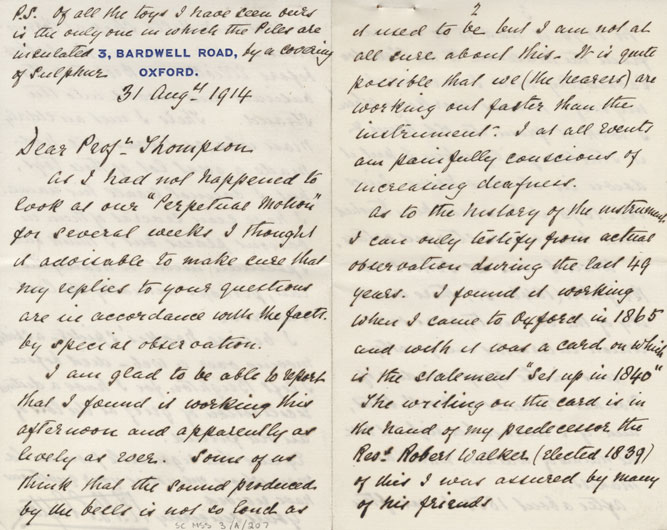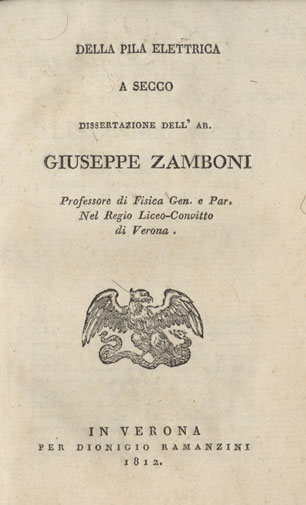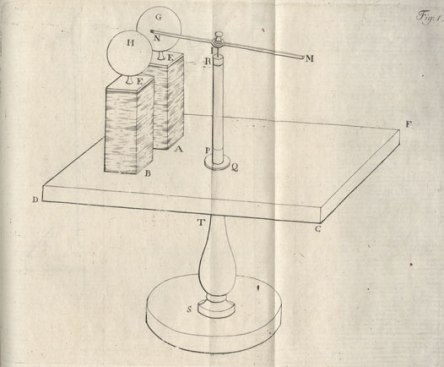Further research on a letter and postcard from 1914 has not only uncovered the letter writer, Robert B Clifton, Professor of Physics at Oxford University from 1865 to 1915, but also brought to light an interesting story about a ‘perpetual motion machine’.
Background to the Letter of 31 August 1914
In this letter R B Clifton, who is writing to Professor Silvanus P Thompson, is clearly answering earlier questions put to him by Thompson about the ‘perpetual motion’ machine, also called a ‘toy’ by Clifton which was held at Oxford University’s Clarendon Laboratory.
This perpetual motion machine is still housed at Clarendon today and is known as The Clarendon Dry Pile or The Oxford Electric Bell, a pair of voltaic ‘dry piles’ connected to two bells which have been ringing at Oxford since it was set up in 1840. Here is a link to Oxford’s online exhibition about The Clarendon Dry Pile including an image – Clarendon Dry Pile
The Letter of 31 August 1914
In the letter, Clifton discusses The Clarendon Dry Pile as follows;
“In 1870 it had to be moved from the Museum to the Clarendon Laboratory and I carried it myself. It was working when I took it from the old house & it started gaily when I put it down in its new home. Since October 1870 it has not been touched and has never stopped action.”
Clifton goes on to say;
“Of all the toys I have ever seen ours is the only one in which the piles are insulated by a covering of sulphur.”
Perpetual Motion Machines and Toys
Perpetual motion, a motion that continues indefinitely without any external source of energy, is impossible due to friction and other sources of energy loss. However, purported perpetual motion machines that could work forever without an energy source and perpetual motion experiments were very popular as ideas/concepts in the early to mid-19th century. Clifton, in his letter, discusses some of these toys, and says;
“When I was at school in Brighton (1846-51) there was a toy of the same type as ours which interested me greatly – it was in the shop corridors of Noakes Chemist etc, North Street, and if I remember right it bore the names of Watkins and Hill as makers. After about 1850 I was often in Watkins and Hill’s shop at Charing Cross – the old shop before Elliott Brothers took the business and moved into the Strand. There I met an elderly man who, as I was told, had made a great lot of these toys, but I cannot recall his name. I have seen several of them in various places but I think our specimen must be nearly the last, perhaps actually the last survivor.”
I believe Noakes’ spider – a spider moving over a web, died before I left Brighton for I have a distinct recollection of grief at the loss of an old friend”.
In his subsequent postcard of 1 September 1914, Clifton mentions another ‘dry pile’ as follows;
“Since I finished my letter I have looked at a Bohnenberger Electroscope supplied by Watkins & Hill to a friend of mine who gave it to me many years ago. The piles, no doubt made by the same man that made those at the Laboratory, are still charged so that the instrument works fairly well when the leaf is a full inch from a terminal of each pile”.
A Bohnenberger Electroscope can be found in Florence’s Museo Galileo and an image and description in English can be found here – Bohnenberger Electroscope.
A Mystery Resolved
Knowing the above story – it becomes very clear why the letter and postcard were stored by S P Thompson in the particular book where the items were found. The book from which the items came was ‘Della Pila Elettrica a Secco. Dissertazione dell’ Ab. Giuseppe Zamboni’ or ‘The Electric Dry Pile. Dissertation’, by Giuseppe Zamboni (1776-1846), published in Verona in 1812. The Zamboni pile was an early electric battery invented by Giuseppe Zamboni in 1812. Images of the title page and figure 1 from this book showing Zamboni piles are shown below.
Who Was Robert B Clifton?
R B Clifton (1836-1921) was the Professor of Experimental Philosophy at Oxford (effectively the Professor of Physics). According to the book ‘Physicists Look Back: Studies in the History of Physics’, edited by J Roche, Clifton was, ‘elected on the basis of one original paper of which he was the junior author and because of the reputation of the excellent lectures he gave as a Professor of Physics at Owen’s College, the forerunner of the University of Manchester’. The book also mentions a, ‘widely accepted view’, that Clifton was chosen by the Electors to the Chair in preference to Hermann von Helmholtz (1821-94) and comments that Clifton had no interest in research, so that during his professorship, there was practically no research at the Clarendon Laboratory.
Experimental Philosophy was first examined as a degree subject at Oxford in 1850 and the Reader, then the Reverend Robert Walker, was promoted to Professor in 1860. Robert Clifton took over from Walker in 1865 and held the office until 1915, the year after this letter and postcard were written. Clifton designed the original Clarendon Laboratory, which was built by 1872 and was the first purpose-built physics laboratory in the British Isles. Further information about the history of Physics at Oxford University, the Clarendon Laboratory and Clifton can be found on the Oxford Department of Physics history web pages here – History of Physics at Oxford
Where Did the Letters Come From?
The habit of S P Thompson to enclose his correspondence with authors, scientists and engineers within books and pamphlets in his library, now in the possession of the IET, has been mentioned in earlier blogs. This letter and postcard written in 1914 by R B Clifton and sent to S P Thompson had been put to one side in the archives some time ago for further investigation as the writer of the letter and postcard had not been determined at that time. A note kept with the items mentioned the book in which the letter and postcard had been found. Not only is this important for tracking the provenance of an item but also the book forms a very interesting part of the story.
The letters were recently recalled from storage and further work uncovered the author of the letter and postcard. Comments made within the letter such as the fact that Clifton had come to Oxford in 1865 and that his predecessor was the ‘Reverend Robert Walker (elected 1839)’, enabled the pinpointing of Clifton as the letter writer, and the signature at the end of the letter in hindsight is very clearly that of R B Clifton. The letter and postcard have been catalogued as items SC MSS 3/A/207 and SC MSS 3/A/208 respectively and can be consulted in the IET Archives.



Leave a comment